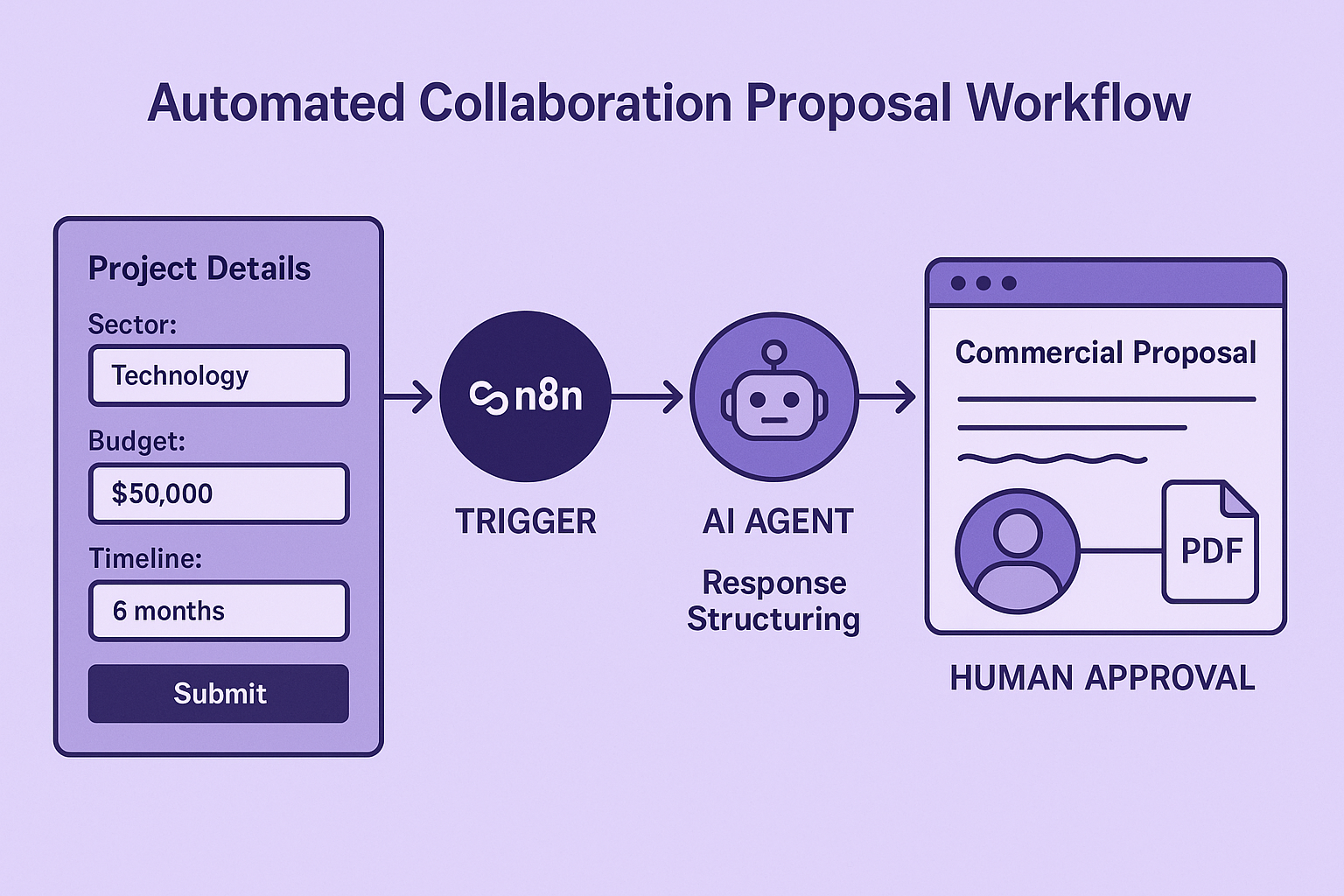In today’s fast-paced business environment, efficiency is key. Automating routine tasks not only saves time but also ensures consistency and reduces human error. This guide explores a powerful example of automation using N8N, an open-source automation tool, to generate and manage collaboration proposals seamlessly.
The Automated Collaboration Proposal Workflow
This automated workflow is designed to quickly generate and send professional collaboration proposals based on client submissions, incorporating an AI agent for intelligent content structuring and a human review step for quality assurance.
The Workflow at a Glance
The process is structured into three main stages:
- Trigger: Initiated by a client filling out an online form.
- Automation: An AI agent processes the form data and structures the proposal details.
- Human Operation: A human reviews and approves or declines the AI-generated proposal before it’s sent to the client.
Let’s dive into each step.
Step-by-Step How-To
Step 1: Client Submission via Online Form
The journey begins with a client expressing interest in a project by filling out a dedicated online form. This form is designed to capture all necessary information to generate an accurate proposal.
- Access the Form: Navigate to the dedicated project proposal form.
- Optional Confidentiality: The platform notes that while filling the form is the primary method, direct visual discussions are also available for highly confidential projects.
- Provide Project Details: Fill in the required fields:
- Start Date: Select the desired project commencement date.
- Sector: Specify the industry or field (e.g., Medical Physics).
- Budget (Optional): Indicate if there’s an approximate budget in mind (e.g., 10,000 euros). If not, leave it blank or state “No budget in mind.”
- Deadline (Optional): Provide an approximate project completion timeline (e.g., 90 days for 3 months).
- Project Description: This is crucial. Provide a detailed description of the project. More information leads to a more tailored proposal. For demonstration purposes, a sample web application description (e.g., “web SPC demo application” with its initial description) can be used.
- Additional Details: Add any specific points or details about the project that are important to consider.
- Company/Website (Optional): Include your company name or website if relevant.
- Submit the Form: Once all details are entered, click ‘Submit’. Upon successful submission, a confirmation message will appear, indicating that the workflow has been triggered.
Step 2: AI-Powered Proposal Generation and Structuring
Once the form is submitted, the N8N workflow takes over. This is where the AI agent comes into play.
- Workflow Execution: The submitted form data triggers the N8N workflow. You can monitor the execution status within the N8N interface under “Executions.”
- AI Analysis: The AI agent processes the project description and other details provided in the form. It “scraps” relevant information and context, even potentially searching the internet for general industry standards or comparable project costs (e.g., pulling data from freelance platforms like Upwork).
- Content Structuring: The AI then structures the proposal content, including:
- An introduction summary of the client’s need (e.g., “a SPC tool”).
- A section on project understanding.
- The proposed approach to the project.
- The overall process.
- A project timeline.
- An investment breakdown, often confirming if the stated budget (e.g., 10,000 euros) is suitable for a comprehensive, reliable, and compliant solution.
- A conclusion.
- Draft Proposal Creation: The AI generates a draft of the collaboration proposal in a structured format, ready for human review.
Step 3: Human Review and Approval
Before the proposal reaches the client, a crucial human review step ensures accuracy, quality, and personalized refinement.
- Approval Request Email: An internal email is sent to the designated reviewer (e.g., a service manager) signaling that a new proposal is awaiting approval. This email includes options to “Approve” or “Decline” the proposal.
- Review the Proposal: The reviewer examines the AI-generated draft. This is the opportunity to:
- Verify the accuracy of the AI’s interpretation.
- Add any specific, personalized touches or elaborations.
- Adjust the language for tone and clarity.
- Ensure all nuances of the client’s request have been addressed.
- Approve or Decline:
- Approve: If satisfied, the reviewer clicks “Approve.” This action triggers the final step of sending the proposal.
- Decline: If the proposal requires further significant changes or is not suitable, the reviewer can “Decline” it, stopping the automatic process and allowing for manual intervention.
- Client Notification: Upon approval, the client receives an email containing the final collaboration proposal. This email typically includes a link to download the proposal as a PDF file, summarizing the project details and the proposed investment.
This entire workflow significantly reduces the time and effort traditionally spent on drafting proposals, allowing businesses to respond more quickly to client inquiries while maintaining a high level of personalization and quality control.
🔍 Discover Kaptan Data Solutions — your partner for medical-physics data science & QA!
We're a French startup dedicated to building innovative web applications for medical physics, and quality assurance (QA).
Our mission: provide hospitals, cancer centers and dosimetry labs with powerful, intuitive and compliant tools that streamline beam-data acquisition, analysis and reporting.
🌐 Explore all our medical-physics services and tech updates
💻 Test our ready-to-use QA dashboards online
Our expertise covers:
🔬 Patient-specific dosimetry and image QA (EPID, portal dosimetry)
📈 Statistical Process Control (SPC) & anomaly detection for beam data
🤖 Automated QA workflows with n8n + AI agents (predictive maintenance)
📑 DICOM-RT / HL7 compliant reporting and audit trails
Leveraging advanced Python analytics and n8n orchestration, we help physicists automate routine QA, detect drifts early and generate regulatory-ready PDFs in one click.
Ready to boost treatment quality and uptime? Let’s discuss your linac challenges and design a tailor-made solution!
Get in touch to discuss your specific requirements and discover how our tailor-made solutions can help you unlock the value of your data, make informed decisions, and boost operational performance!

Comments